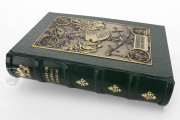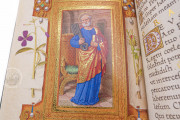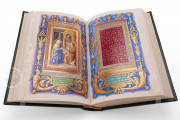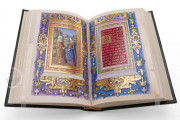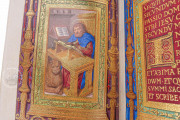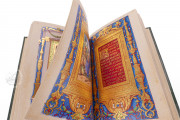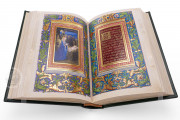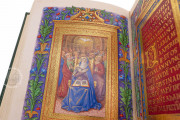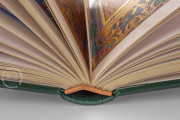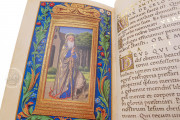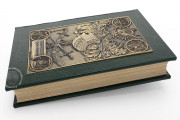The Hours of Frederick of Naples is a deluxe Christian prayer book copied and illuminated in Tours around 1501-1504 for Frederick I, exiled King of Naples. The city's master illuminator, Jean Bourdichon, painted the book's sixty-four exquisite full-page miniatures. The ninety-nine elaborate borders surrounding the miniatures and the imposing painted text pages are the work of Frederick's court artist Giovanni Todeschino, who is believed to have traveled with the king to Tours, and the Master of Claude of France.
The manuscript opens with the Gospel accounts of the Passion of Christ and includes: five votive masses; the prayer services of the Hours of the Virgin, the Hours of the Cross, and the Hours of the Holy Spirit; the Penitential Psalms; more prayers; and suffrages of saints.
Exquisite Miniatures
Jean Bourdichon painted his miniatures on thin parchment, which was glued into place at the beginnings of major textual divisions. Most of the miniatures depict scenes from the life of Christ and portraits of standing saints. The protagonists appear as imposing figures filling the foreground, creating an intimate experience with the divine for the devotee.
Captivating Night Scenes
Bourdichon's miniatures often feature deep atmospheric settings—most evocative in night scenes. These include the Nativity of Christ, the scene illuminated from within the stable by an aura emanating from the infant Jesus and by Saint Joseph's lantern (p. 134). Bourdichon's delicate gold highlights on figures and landscape elements make every miniature shimmer, especially in the subjects set at night, such as the Arrest of Christ, another scene with a depicted lantern providing a light source (p. 178).
A True Collaboration
Giovanni Todeschino is responsible for the borders surrounding Bourdichon's miniatures (on left-hand pages) in the heart of the manuscript (from the Hours of the Virgin to the Office of Dead; pp. 107-281). The young Master of Claude of France imitated his style and motifs in creating borders on the facing pages.
One pair of borders, for the miniature of the Virgin and Child on a Crescent Moon and the opening of the popular Marian prayer O Intemerata, is the work of Bourdichon (pp. 324-325). Each border is composed of flowering vines of beans set against a gold ground.
Splendid Illusionism
Todeschino's borders are illusionistic tours-de-force that create fictive frames featuring precious stones, gems, and pearls formed into garlands dotted with golden sculpted sirens, masks, sphinxes, and other motifs inspired by ancient Roman art. Some borders include fictive plants. Three borders also employ the device, favored in the Veneto, of creating the illusion of the parchment of the page curling (pp. 198-199 and 332).
Prayers for a King
Although Frederick lost his title of King of Naples in 1501, the royal coat of arms of the Neapolitan House of Trastámara occupies a whole page at the end of the manuscript (p. 388). Frederick enjoyed a "golden exile" in Tours, where he brought many of his retainers, his library, and his art collection.
The Script of Humanism
An Italian scribe in Frederick's entourage copied the manuscript's text in Humanistic Minuscule. The scribe has written the text on the final pages of each section of text in lines of varying length, creating pleasing geometric patterns. Every sentence opens with a decorated initial of mauve on a gold ground, the work of a French artist.
Long Road to Paris
Following Frederick's death, the manuscript may have been owned by his widow, Isabella Del Balzo (1468-1533), Queen of Naples, and their son, Fernando of Aragon (1488-1550), Duke of Calabria. It was later in the possession of Joseph Bonaparte (1768-1844), King of Spain, before being taken to Great Britain. It was then owned by someone named Fergusson and acquired in 1828 by the French Royal Library (later Bibliothéque nationale and, since 1995, Bibliothéque nationale de France).
We have 1 facsimile edition of the manuscript "Hours of Frederick of Naples": Libro de Horas de Federigo de Aragona facsimile edition, published by CM Editores, 2021
Request Info / Price

